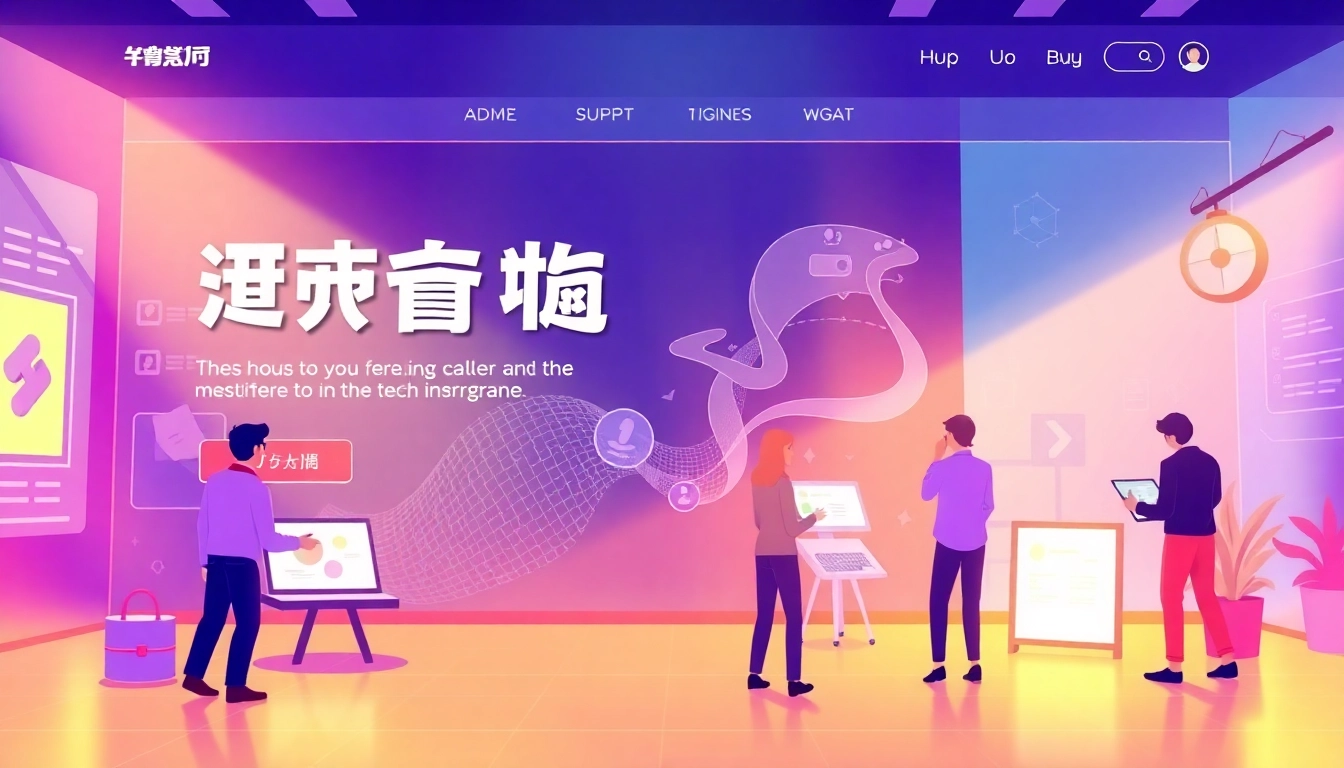Understanding the Fundamentals of Web Development
Web development encompasses a broad range of activities essential for creating and maintaining websites. It involves both technical and creative tasks, including programming, design, and content management. As businesses and individuals increasingly rely on digital platforms to communicate, sell, and interact, mastering web development has become more important than ever. This comprehensive guide will delve into various aspects of web development, essential skills, best practices, and emerging trends, making it a valuable resource for anyone looking to enhance their expertise in this field.
What is Web Development?
Web development is the work involved in developing a website for the Internet (World Wide Web) or an intranet (a private network). This process encompasses several disciplines that need to combine diverse professional skills and knowledge, including:
- Web design
- Frontend and backend development
- Database management
- Content management
- Web server configuration
- SEO optimization
Web development can be thought of as a continuum that ranges from simple static pages to complex web-based applications, including e-commerce sites, content management systems, and web services. Each of these components plays a crucial role in delivering an optimal user experience and achieving business goals.
Key Components of Web Development
The development process can be broadly categorized into three main types:
- Frontend Development: This focuses on everything users see on their browsers. It includes HTML, CSS, and JavaScript, allowing developers to create visually appealing and responsive interfaces.
- Backend Development: This involves the server, database, and application logic that power the website. The backend manages data and ensures communication between the server and the client-side.
- Full-Stack Development: Full-stack developers have the skills to work on both the frontend and backend of a website, enabling them to oversee the entire development process.
The Importance of Web Development in Today’s Digital Landscape
In an era where digital presence is pivotal for success, web development is more critical than ever. A robust online platform not only helps businesses reach their customer base but also fosters engagement and drives sales. Here are key reasons why web development is essential:
- Visibility: A well-developed website increases visibility on virtual platforms, enhancing brand recognition.
- User Engagement: Interactive and responsive designs keep users engaged, improving time on site and conversion rates.
- Business Growth: With e-commerce on the rise, effective web development can significantly contribute to business expansion and revenue growth.
- SEO Ranking: Search engine optimization strategies are enhanced by effective web development practices, leading to higher placement in search engine results.
Essential Skills for Web Development
Front-End Development Skills
Front-end developers are responsible for the visible parts of a website. Their skills include:
- HTML/CSS: Proficiency in HTML and CSS is fundamental for structuring and styling web pages.
- JavaScript: Essential for creating interactive features like buttons, forms, and animations.
- Responsive Design: Understanding of mobile-first design principles to ensure websites perform well on various devices and screen sizes.
- User Experience (UX): Ability to create intuitive and user-friendly interfaces that enhance user satisfaction.
- Version Control/Git: Knowledge of version control systems to manage and track changes in source code.
Back-End Development Skills
Back-end development involves server-side programming and databases. Key skills include:
- Server Management: Understanding server configurations and maintenance to ensure optimal operation.
- Database Management: Knowledge of databases like MySQL, MongoDB, or PostgreSQL to store and retrieve data efficiently.
- Languages: Proficiency in server-side languages such as PHP, Python, Ruby, or Java to build server applications.
- API Integration: Capability to integrate and interact with various APIs to facilitate communication with other systems.
- Security Measures: Understanding cybersecurity best practices to protect data and user information.
Understanding Full-Stack Development
Full-stack development encompasses the full spectrum of web development. Full-stack developers bridge the gap between front-end and back-end development, possessing the following skills:
- Versatility: Ability to work on both client-side and server-side technologies, offering a holistic approach to web development projects.
- Problem Solving: Strong analytical skills to troubleshoot and optimize the entire web application’s performance.
- Framework Familiarity: Knowledge of popular frameworks like Node.js, Vue.js, Angular, or React, depending on the project type.
- Agile Methodologies: Understanding of Agile principles to collaborate efficiently with cross-functional teams.
Best Practices in Web Development
Responsive Design Techniques
Responsive design is crucial in today’s mobile-driven world. This practice ensures that websites adapt to various screen sizes and devices. Key techniques include:
- Fluid Grids: Use of relative units (like percentages) rather than fixed units (like pixels) to create a flexible layout.
- Media Queries: Employing CSS media queries to apply different styles based on device characteristics.
- Flexible Images: Ensuring images can resize within their containing elements without distorting.
Optimize Performance and Speed
Website performance significantly impacts user experience and search engine ranking. Best practices for optimization include:
- Minification: Reducing file sizes for CSS and JavaScript to decrease load times.
- Image Optimization: Compressing images to reduce loading time without compromising quality.
- Caching: Implementing caching strategies to store frequently accessed data on the client side, improving site loading times.
- Content Delivery Networks (CDNs): Utilizing CDNs to distribute content efficiently across various geographic locations.
Ensure Accessibility and User Experience
Creating an inclusive web experience is vital, as it allows everyone, regardless of their abilities, to access information. Key strategies include:
- Keyboard Navigation: Ensuring the site can be navigated using a keyboard without requiring mouse use.
- ARIA Roles: Implementing Accessible Rich Internet Applications (ARIA) roles and attributes to enhance screen reader functionality.
- Color Contrast: Using adequate color contrast ratios to ensure readability for users with visual impairments.
- Alt Text: Providing descriptive alt text for images to assist users relying on screen readers.
Web Development Tools and Technologies
Popular Programming Languages for Web Development
A variety of programming languages are used in web development, each catering to specific development needs. Some of the most commonly used languages include:
- HTML: The backbone of all web pages; it structures web content.
- CSS: Enables developers to style HTML elements, promoting better aesthetics and layout control.
- JavaScript: Adds interactivity to websites, with extensive libraries like jQuery and frameworks like React enhancing capabilities.
- PHP: Widely used for server-side scripting and dynamic website content.
Frameworks and Libraries
Frameworks and libraries streamline the web development process, enabling developers to follow structured methodologies. Prominent options include:
- Frontend Frameworks: React, Angular, and Vue.js all provide robust front-end developments.
- Backend Frameworks: Node.js, Django (Python), and Ruby on Rails are ideal for backend solutions.
- CSS Frameworks: Bootstrap and Tailwind CSS offer pre-built components for rapid styling.
Development Environment and Tools
A well-configured development environment is crucial for productivity. Here are essential tools:
- Code Editors: Editors like Visual Studio Code, Sublime Text, and Atom support efficient coding with features like syntax highlighting.
- Version Control Systems: Git is popular for tracking changes and collaborating across development teams.
- DevOps Tools: Tools like Docker and Jenkins automate tasks and streamline deployment processes.
Career Opportunities in Web Development
Paths to Becoming a Web Developer
The path to a web development career varies widely depending on individual backgrounds and aspirations. Common routes include:
- Bachelor’s Degrees: Pursuing a degree in computer science, IT, or software engineering provides foundational knowledge.
- Bootcamps: Short-term intensive programs focusing on practical skills and project-based learning.
- Online Courses: Many platforms offer tailored web development courses, accommodating different skill levels.
Job Market Trends in Web Development
The demand for web developers remains strong, driven by the ongoing digital transformation across industries. Trends influencing the job market include:
- Remote Work: The rise of remote job opportunities has broadened the talent pool for web developers.
- Specialization: Employers seek specialized skills in areas such as UX/UI, mobile development, and API management.
- Increased Automation: Adjacent technologies like Artificial Intelligence and machine learning are reshaping traditional roles.
Building a Portfolio and Finding Clients
A strong portfolio showcasing various projects is essential for standing out in a crowded job market. Strategies to build an impressive portfolio include:
- Personal Projects: Develop and display personal web projects to demonstrate your skills and creativity.
- Freelance Work: Take on freelance projects to gain real-world experience and client testimonials.
- Collaboration: Collaborate with other professionals on projects to showcase teamwork and diverse skill sets.















Leave a Reply